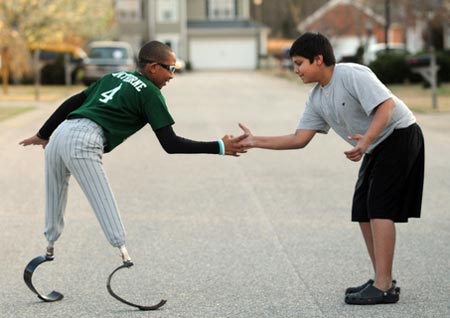Find ways to re-grow limbs in humans
Restoring the original shape of the limbs, broken bones and damaged brains can become a reality after scientists discover a particular gene.

If scientists succeed in turning off the p21 gene, those who lose their legs and arms can recover lost body parts.Photo: al.com.
Many scientists believe that the ability to restore body parts previously existed in all animals, but in the process of evolution that ability is lost and only exists in a few species - some of them amphibians.
Telegraph said the Wistar Research Institute scientists discovered a gene capable of preventing damage recovery. It is called p21. The team found that deaf mice recovered hearing after they turned off the p21 gene in their bodies.
In animals, the body heals wounds by creating scars. But the deaf mice lacking the p21 gene repair damaged tissue in the ear to create a spore - an important ingredient in cell development. The parts of the animal body all grow from spores.
The disappearance of p21 causes the mouse body not to produce normal cells but to create stem cells - the type of cells that can turn into all types of tissue in the body. Stem cells act as 'repair kits' because they replace tissue, dead or too old cells.
In normal cells, p21 is like a brake because it is responsible for blocking the cell growth cycle every time the DNA is damaged. If the DNA is damaged and p21 doesn't work, the cell will be at risk of becoming cancerous after dividing.
Although the test to turn off the p21 gene has only been conducted in mice, scientists claim they can completely turn off the same gene in the human body in some way, such as taking medicine. If this effort succeeds, restoring the dead limbs, broken bones and even damaged brains will become a reality.
Professor Ellen Heber-Katz, the leader of the study, commented: 'Like newts, mice will replace damaged or lost tissue with healthy tissue. That process leaves no scars. We hope one day we can speed up the recovery of human injury by temporarily turning off the p21 gene.
- Humans can 'grow back and forth' like reptiles
- Animals that can 're-grow limbs' appear 300 million years ago
- Why are limbs cold in winter?
- Where did the red hair grow?
- Techniques of growing clean vegetables in simple foam pots at home
- Learn how to recreate the bizarre arm of jellyfish
- Are people about to regrow their limbs like salamanders?
- How to help you avoid hateful numbness
- How to grow and care vy wing flowers
- Robots have muscles like humans
- Monkeys are more susceptible to disease when near people
- Research on flies paves the way for new ways of healing in humans
 Why do potatoes have eyes?
Why do potatoes have eyes? 'Tragedy' the world's largest carnivorous life: Death becomes ... public toilet
'Tragedy' the world's largest carnivorous life: Death becomes ... public toilet Tomatoes were once considered 'poisonous' for 200 years
Tomatoes were once considered 'poisonous' for 200 years Detecting microscopic parasites on human face
Detecting microscopic parasites on human face